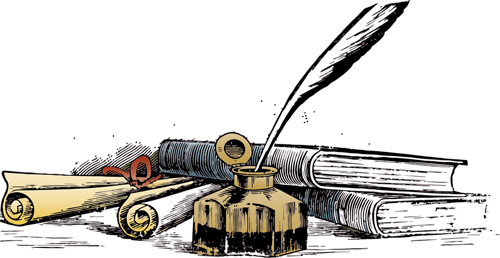Geologist and science writer Nina Morgan provides some advice on how to cure writer's block
Morgan, N. Distant Thunder: Pen to paper.
Geoscientist 29 (2), 28, 2019
https://doi.org/10.1144/geosci2019-012;
Download the pdf here

Nothing can induce more panic in the heart of many a geologist than the combination of a looming text deadline and the sight of a blank page. If that's you, take heart. You are not alone. Percy Fry Kendall [1856-1936], Professor of Geology at the University of Leeds from 1906-1922, felt exactly the same.
Writing to Herbert E. Wroot [1869-1939], Honorary Secretary of the Yorkshire Geological Society, in October 1928 he confessed:
"While you objurgate I wrestle with my task. I'm sure it is difficult for the practised writer to realise the loathing for the pen that fills the unpractised. I sit down and with many sighs take up the dreaded implement and after scanning the last previous attempt decide that it won't do, so make a fresh start – almost day by day the same irritating round..."
The answer
Kendall's solution? Find a good collaborator. And in this quest, he was lucky enough to team up with Wroot, a writer who joined the staff of the Yorkshire Post in 1920 and contributed a much-loved weekly Nature Lover's Diary, written, as one reader described it "... with charm and exactness ..."
Although interested in natural history, Wroot was not a trained geologist. He had a broad scope of interests in other fields, including history and literature, and published several studies related to the Brontës and edited the publications of the Brontë Society for six years, in the early 20th century. Wroot was also one of the founders of the Yorkshire Dialect Society. He joined the Yorkshire Geological Society in 1909 and was made both Secretary and Editor in 1917. He was celebrated as Secretary for his encouragement of amateur geologists and as Editor for his work to make the academic and professional papers read at the meetings intelligible to the layman.
Perfect pair
In his quest to promote geology for all, Wroot found his ideal geologist and co-author in Kendall. Born in Clerkenwell, Kendall, a studious reader, naturalist and collector, never went to school, but later studied at what is now Imperial College London and the Royal School of Mines. Among his teachers were the geologists Jonathan Sollas [1849-1936] and J.W. Judd [1840-1916], as well as the biologist T.H. Huxley [1825-1895]. In 1891 he became a part-time lecturer at Yorkshire College, Leeds and then, in 1906, Professor of Geology when the College attained full university status.
Academically, Kendall is perhaps best known for his work on glaciology, but he also carried out important research on the Carboniferous Coal Measures, as well as studies of underground water in the Carboniferous Limestone in the Craven Uplands and the source of the River Aire. In addition, he contributed to work on water supplies to villages and towns. He remained at Leeds University until his retirement in 1922. In 1924 he was elected a Fellow of the Royal Society and in 1926 the University of Leeds awarded him an honorary doctorate.
For ten years, from 1912 to 1922 Kendall and Wroot often met on Sunday mornings, when Wroot listened to Kendall discuss his knowledge of the geology of Yorkshire. The upshot, notes Wroot's obituarist in the Proceedings of the Yorkshire Geological Society, was that Wroot "came to a better understanding of geology through a knowledge of the life of those who were engaged in it."
Weighing in
The product of these fruitful discussions was a hefty tome, The Geology of Yorkshire. The manuscript was completed by 1922, but declined by several English publishers who believed it would be "impossible to make a localised book pay". Rather than allow their work to be wasted, Kendall and Wroot had it printed privately in Vienna in 1924. The book, intended for all interested in the landscape, geology and scenery of Yorkshire, whether amateur, academic or professional geologist, serves both as a geological and a 'tourist' guide to the county. Along with geology, it also features sections such as 'Yorkshire from a railway carriage window' and 'Specimen days in Yorkshire'.
Although it's not clear who actually did all the writing, the fact that this readable book, running to 995 pages and weighing in at nearly 2 kg, came out at all suggests that Kendall really did find the perfect way to conquer writer's block.
End notes: Thanks to Duncan Hawley for drawing my attention to the letter from Kendall to Wroot, which can be found at
https://www.bradfordmuseums.org/blog/kendall-wroot-digitization-project/. Other sources for this vignette include the obituaries for Herbert Wroot, which appeared in Proceedings of the Yorkshire Geological Society, 24, 71-75, 1 January 1938 and Brontë Society Transactions, 9:4, 257—259, 1939; a biographical article about Percy Fry Kendall by David Rowe available at
www.ypsyork.org/resources/yorkshire-scientists-and-innovatior/kendall; and the obituary of Kendall that appeared in Nature, 137, 692 – 693, 1936.
Nina Morgan is a geologist and science writer based near Oxford. Her latest book, The Geology of Oxford Gravestones, is available via www.gravestonegeology.uk